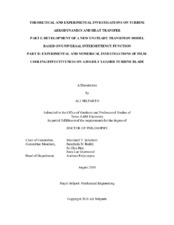| dc.description.abstract | The flow around a gas turbine blade is inherently three-dimensional and based on the Re-number and the blade geometry, it may be laminar, transitional or turbulent. The blade surfaces are subject to periodic unsteady wakes that originate from the upstream stator/rotor rows. The wakes with their highly vortical cores impinge on the downstream blade surfaces and cause an intermittent transition of the boundary layer from laminar to turbulent. The intermittent behavior of the boundary layer under periodic wake flow condition is characterized in several publications from TPFL (Turbomachinery Performance and Flow Research Lab). Intermittency at each location varies between a maximum and a minimum value at different times. Maximum intermittency corresponds to the intermittent behavior of the flow inside the blade boundary layer once it is subjected to the wake vortical core and minimum intermittency characterizes the nature of the boundary layer when it is subject to non-turbulent flow region between the wakes. The correlation between minimum, maximum and instantaneous intermittencies is best described by the universal intermittency function that has a Gaussian distribution. In the current study, a transport equation for intermittency has been derived from previously obtained experimental measurements. This transport equation is revisited for the curvilinear coordinate system and was implemented in a RANS solver to model the transient behavior of the flow on the suction surface of a turbine blade. It was later integrated with a turbulence model, and the results were validated against experimental measurements and transitional-SST turbulence model. The benchmark data, used for derivation and validation, were obtained in the cascade facility at TPFL. The facility simulates the periodic wake flow by moving rods attached to two parallel timing belts in front of the blade cascade. All calculations were conducted at Reynolds number of 414,000.
Also, another effort has been made to measure film-cooling effectiveness on the suction and pressure surfaces of a low-pressure turbine blade utilizing the same cascade facility. Low-pressure turbine blades are not necessarily exposed to critically high temperatures and for that reason, cooling technologies are not very common in these stages of the engine. Yet, the film-cooling experiments were designed with the purpose of understanding the effects of the underlying physics of the transitional flow on filmcooling effectiveness. The flow around this turbine blade has unique characteristics. The flow regime is transitional and, especially in off-design conditions, it is often accompanied by flow separation and rapid change of pressure gradient as well as unsteady incoming wakes that could impinge on the blade surface and penetrate the boundary layer. These flow features add to the level of complexity of this case. For the experiments, the flow coefficient is maintained at 0.8, and the incoming wakes in experiments have a reduced frequency of 3.18. Film-cooling effectiveness under periodic unsteady flow condition was studied using Pressure-Sensitive Paint. Experiments were performed at Reynolds number of 150,000 and blowing ratio of 1, based on equal mass flux distribution. It was determined that HTC and FCE behave in opposite manners for the most part. This behavior is justified from turbulence intensity and velocity fluctuation perspective. Also, unsteady wakes show opposite effects on suction and pressure sides of the blade. | en |


